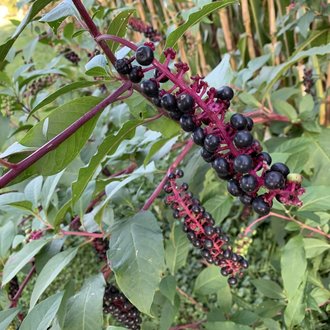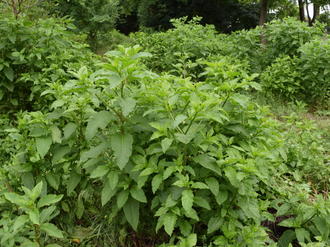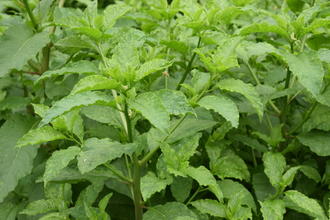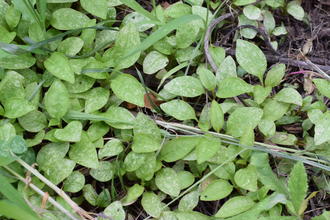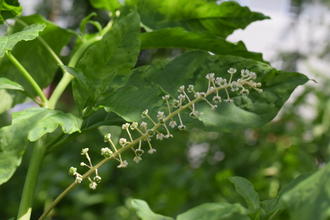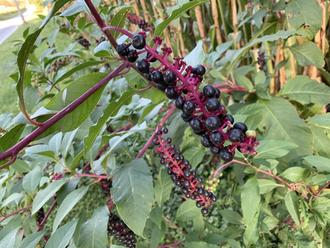American Pokeweed (Phytolacca americana L.)
↑Summary
An herbaceous perennial plant, abundant in Eastern North America. Native, but commonly viewed as a weed.
↑Range - Expand
| Legend | Color |
| Native | |
| Introduced | |
| Native or Not Present | |
| Introduced or Not Present | |
| Native or Introduced | |
| Native or Introduced or Not Present |
This tentative map is based on our own research. It may have limited data on Canada and/or Mexico, and there is some subjectivity in our assignment of plants as introduced vs. expanded. Read more in this blog post.
Although this plant occurs somewhere in each of these regions, it may only occur in a small part of some or all of them.
↑Description & Identification
American Pokeweed is a large herbaceous perennial, growing from a taproot. It grows to about 9m/10ft tall, shorter on dry sites or sites with poor soil. It branches regularly, giving it a shrub-like appearance. It has simple leaves on stalks that start out greenish, becoming red to purplish with age. The stems are hairless and round. The leaves are large among similar-sized plants, reaching 10" in length and 4" in width.
Flowers are born in a raceme that usually starts out erect and begins drooping as fruit develops. The berries are juicy and dark purple when ripe.
After the plant dies from frost in the autumn, a skeleton of straw-colored stalks often remains through the winter.
The plant is distinctive and not confused with any other species in most of its range, although it can be confused with Phytolacca icosandra, a plant that, in North America, only occurs in a few of the warmest regions of the southwestern U.S, Phytolacca octandra, occurring only in Arizona and also one county in Wisconsin, and Phytolacca heterotepala (Mexican pokeweed). The few other Phylotacca species occurring in North America are easily distinguished. All of these other species have very limited distributions.
↑Habitat
Prefers part sun, moist conditions, and rich, loamy soil, but adaptable to a range of sunlight conditions and poorer soils.
Most abundant in disturbed antropogenic habitats, especially edge habitats, partly shaded areas along roads and railroads, vacant lots, industrial areas, and weedy suburban yards, but also found in natural forest edges and meadows.
↑Life Cycle
Pokeweed is long-lived among perennials, and can survive for years, usually persisting as long as it has suitable conditions.
Pokeweed sprouts from seed and usually requires exposed conditions with some direct sunlight for plants to survive to maturity. Once established, however, it can persist in more shaded conditions and tolerate substantial competition from other plants, due to its ability to store extensive energy in its root and quickly grow taller than most non-woody plants at the start of the growing season.
The above-ground parts are not frost-tolerant; it usually emerges after the threat of frost is past, and the plant usually dies back to the root at the first frost.
Fruits are distributed primarily by birds.
Disturbance favors this plant at virtually all stages in its life cycle: its seeds germinate readily in exposed soil and when vegetation has been removed, but adult plants vigorously resprout whenever all the vegetation in an area is removed.
↑Faunal Associations
This species is eaten by some insects, but mostly by generalist herbivores. It is one of many hosts of the Giant Leopard Moth. (source) The flowers attract mostly syrphid flies and halictid bees.
Fruits are eaten by many species of bird as well as mammals. Some birds also eat the seeds inside the berries. The mature foliage is avoided by most mammals due to toxicity.
↑Uses
Pokeweed is uncommonly grown as an ornamental plant; it has visually-distinctive features such as the purple berries, flower clusters, and bold purple-red mature stems, that can make it attractive, but its aggressive spreading usually discourages most gardeners from growing it.
Pokeweed has been eaten as a food, primarily in the Southern U.S., and was even canned and sold commercially, under the Allens brand, as "Poke Salet greens". Because of the plant's toxicity, it is traditionally prepared by gathering only using the tips of young shoots, and then boiling them in multiple changes of water.
The berries of pokeweed have been studied for potential applications in solar energy: a red dye made from the berries has been explored as a coating on inexpensive fiber-based solar cells.
↑Related Plants
Phytolacca americana is the only plant of its genus across most of North America. According to USDA and BONAP maps, there are isolated populations of tropical pokeweed (Phytolacca icosandra), in the Southwestern U.S., and southern pokeweed (Phytolacca bogotensis) has been introduced in Maryland and mexican pokeweed (Phytolacca heterotepala) in California.
Worldwide, there are numerous other Phylotacca species. Most are herbaceous perennials, but Phytolacca dioica, native to a tropical-to-subtropical region of South America, is a large tree.
The broader family, Phytolaccaceae, however, has several genera of plants found in North America, mostly in Southern Florida and/or Texas, including the the native plants Petiveria alliacea, Rivina humilis, Trichostigma octandrum, and introduced plants Agdestis clematidea, Gisekia pharnacioides. Stegnosperma cubense is native to Puerto Rico and the Caribbean but not found in North America.
The broader grouping, the order Caryophyllales, has large numbers of plants whose ranges overlap with P. americana.
↑Notes
Pokeweed is a common plant that has become more widespread in large part due to human intervention. It thrives in border areas, suburban yards and gardens, pastures, fields, and areas along roads or railroads. Periodic mowing or cutting back of foliage or vegetation tends to favor or benefit this plant, especially when carried out early in the growing season before it has invested much energy in growth. It can usually survive being cut back to the ground multiple times in the same growing season.
↑Links & External Resources
• Phytolacca americana (Pokeweed) | Illinois Wildflowers (About This Site)
• Phytolacca americana (American pokeweed) | USDA PLANTS Database (About This Site)
• Phytolacca americana | Go Botany (About This Site)
• Phytolacca americana (Pokeweed) | Missouri Botanical Garden Plant Finder (About This Site)
• Phytolacca americana | Biota of North America Project (BONAP) (About This Site)
• Phytolacca americana | NatureServe Explorer (About This Site)
• Phytolacca americana | Flora of North America (About This Site)
• Phytolacca americana | Missouri Plants (About This Site)
• American Pokeweed | Maryland Biodiversity Project (About This Site)
• Phytolacca americana L. var. americana (Common Pokeweed) | Digital Atlas of the Virginia Flora (About This Site)
• Phytolacca americana L. var. rigida (Small) Caulkins & Wyatt (Seaside Pokeweed) | Digital Atlas of the Virginia Flora (About This Site)



